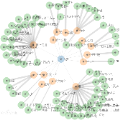Knowledge graph (KG) question generation (QG) aims to generate natural language questions from KGs and target answers. Previous works mostly focus on a simple setting which is to generate questions from a single KG triple. In this work, we focus on a more realistic setting where we aim to generate questions from a KG subgraph and target answers. In addition, most of previous works built on either RNN-based or Transformer-based models to encode a linearized KG sugraph, which totally discards the explicit structure information of a KG subgraph. To address this issue, we propose to apply a bidirectional Graph2Seq model to encode the KG subgraph. Furthermore, we enhance our RNN decoder with node-level copying mechanism to allow directly copying node attributes from the KG subgraph to the output question. Both automatic and human evaluation results demonstrate that our model achieves new state-of-the-art scores, outperforming existing methods by a significant margin on two QG benchmarks. Experimental results also show that our QG model can consistently benefit the Question Answering (QA) task as a mean of data augmentation.
翻译:知识生成( KG) 问题解答 QG ) 的目的是从 KGs 和 目标解答中生成自然语言问题。 先前的工作主要侧重于一个简单的设置, 即从一个 KG 三进制中生成问题。 在这项工作中, 我们侧重于一个更现实的设置, 目的是从一个 KG 子图和目标解答中生成问题。 此外, 先前的多数工作建立在基于 RNN 的模型或基于变异器的模型上, 以编码线性 KG sugraph 的模型, 完全抛弃了 KG 子图的清晰结构信息 。 为了解决这个问题, 我们提议应用双向图形2Seq 模型来编码 KG 子图解答。 此外, 我们用节点的复制机制加强我们的 RNNN 解码器, 以便直接复制 KG 子图到输出问题的节点属性。 自动和人类的评估结果都表明, 我们的模型取得了新的艺术评分, 在两个 QG 基准上以一个显著的差来表现现有方法 。 。 实验结果还显示, 我们的QG 模型可以持续地 使 QG 解答( QA) 增加 任务中的数据成为一种平均值。



